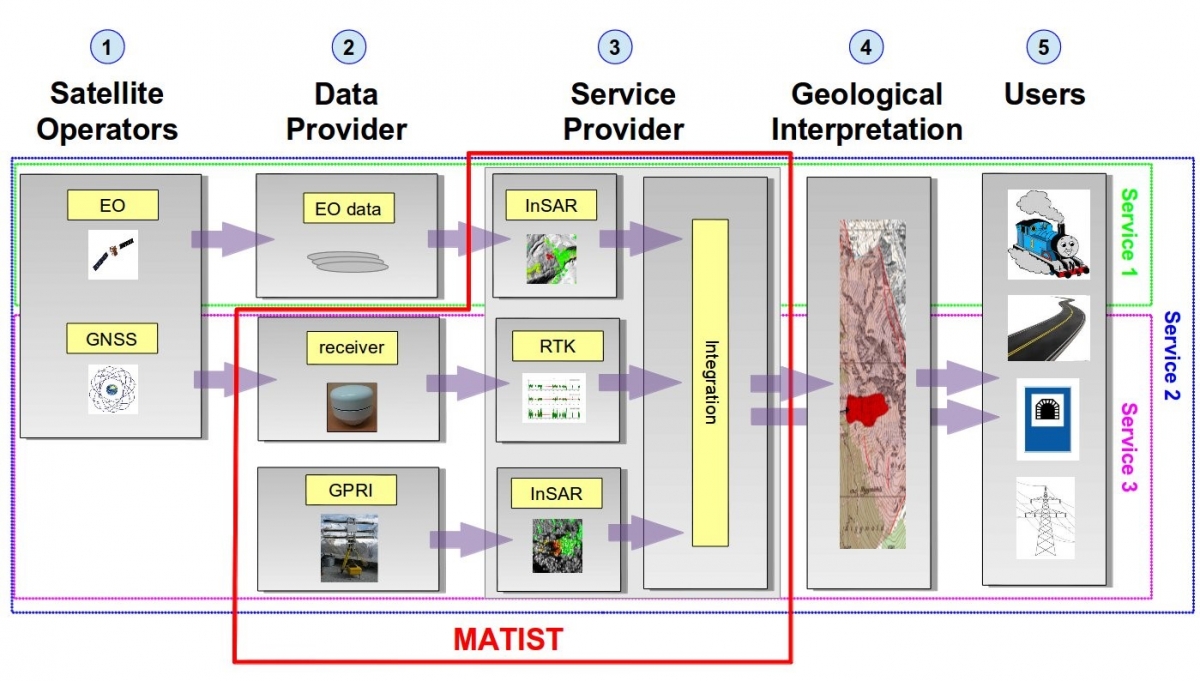
Objectives of the service
The objective of the MATIST (Monitoring Alpine Transportation Infrastructure using Space Techniques) feasibility study was to evaluate the technical feasibility, economic viability as well as the sustainability of services to the Alpine transportation infrastructure operators that are based on the integration of the space techniques radar interferometry and satellite navigation. The information to be provided is ground motion, including the motion of the transportation infrastructure (railway, roads), motion of rocks or terrain slopes above transportation infrastructure, and motion caused by tunnelling.
Users and their needs
The end users to whom our proposed service is aiming at are the operators of the Alpine transportation infrastructure. In the case of railways these are the railway infrastructure managers. In the case of the roads these are institutes representing the national, regional, or community level governments, depending on the type of roads. Further transportation infrastructures include pipelines and power lines which are operated by companies from the energy sector. Finally, for the construction of new rail or road links, constructor companies owned by one or more partners might be created and are also considered in our analysis. As a result, the end-users include small to large companies, as well as public institutes.
For land displacement monitoring services the infrastructure operators are often complemented by private geological offices. Such external geological offices are proposing monitoring solutions to the infrastructure operators and are in many cases performing the analyses in the framework of contracts with the infrastructure operators. Geological consultancy is not included in the services provided by the MATIST solution. Therefore, the solution under consideration here is well suited to complement the services already provided by geological offices and these latter are therefore also important stakeholders in our service concept.
Reference users of the project to support the identification of needs and conditions, as well as evaluate the results of the Proof of Concept include:
- The Swiss Federal Railways (SFR);
- The Austrian Federal Railways (OeBB);
- The Swiss Federal Office for the Environment (FOEN), the authority responsible for preparing decisions to secure a comprehensive and coherent policy of prevention of natural hazards;
- The Austrian motorway operator ASFINAG;
- Kellerhals+Häfeli AG, a Swiss geology office whose activity changed over the years from engineering geology to environmental issues and natural hazard management.
Service/ system concept
The concept envisaged for the MATIST services is illustrated in Figure 1. Aligned with the user needs, we defined three services:
Ser. 1 → wide-area investigations of slope instabilities with satellite SAR interferometry;
Ser. 2 → repeated monitoring of selected slopes of relevant hazard with satellite SAR interferometry, terrestrial radar interferometry and GPS/GNSS;
Ser. 3 → ground deformation monitoring in near real time with terrestrial radar interferometry and GPS/GNSS.
Integration of the proposed technological solutions as well alignment of the envisaged solution to those already provided to the identified users by geological offices are essential in order to be able to derive ground motion data in a large number of situations, obtain high quality of data in space and time with cross-validation of results, and ensure user's acceptance. Limiting the service to a single technical solution will indeed preclude its broader application. Usual practice in the user's environment is, if an alert system is not in place, to deliver results of mapping and monitoring activities as reports and maps after a certain time needed to analyse the data.
The service provision chain includes at its two edges the satellite operators higher up in the chain and final users lower down. For services based on satellite SAR interferometry the relevant players are satellite data providers, service provider and the end-user. For terrestrial radar interferometry the service provision chain is even simpler as there are no external data providers, data and service provider are the same entity. For the GPS/GNSS component there are at the present two basic business models considered. The first one is that data and service are provided by an external partner with GPS/GNSS competence. In this case, this part of the service is offered as an external element or directly to the user. The other possible business model would be that we also provide the GPS/GNSS component, requiring the purchase of the sensors. In all our considerations we assume that the GPS/GNSS signal will remain freely available also in future. If geological offices are considered for the interpretation of the displacement maps, they are for us either end-users (or customers), if our service is initiated by them, or an external part of the service provision chain who is of course making money out of its effort.

Space Added Value
The space assets mobilized for this project are:
- Earth Observation: satellite SAR interferometry for surface displacement mapping and monitoring
- Satellite Positioning: to accurately measure surface displacement.
The foreseen added value of using different space assets along to terrestrial assets (terrestrial radar interferometry) is:
- Large area mapping from space;
- Improved completeness and consistency of the results;
- Reduced costs.
Current Status
The Feasibility Study, started at the end of November 2012, has been successfully completed, with all meetings having taken place and all deliverables submitted. The Final Review meeting took place on 22/23 January 2014. The MATIST project demonstrated the overall feasibility of the intended solution for the provision of ground-motion information to operators of the alpine transportation infrastructures. From a commercial point of view the proposed solution is considered sustainable and of benefit for both service provider and users. The proposed technologies (satellite SAR interferometry, terrestrial radar interferometry, GPS/GNSS) are generally at a high level of development if considered individually, but their high-level integration into a sustainable solutions still needs to be consolidated and also the performance of the low-cost GPS/GNSS communication elements requires improvements. Therefore, in order to fully deploy the intended services, further investments are required. Currently, there are no plans to propose a Demonstration Project.


